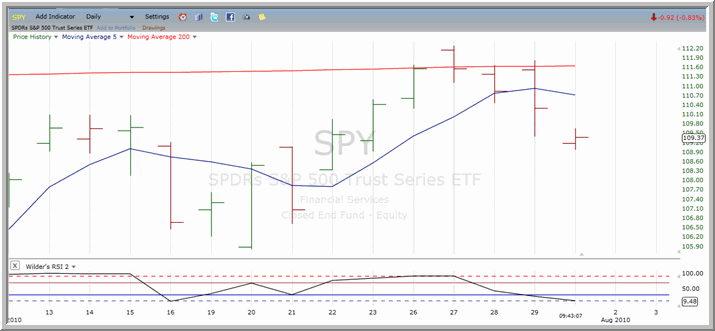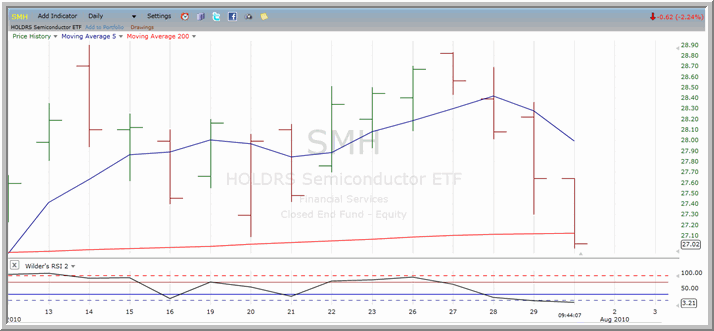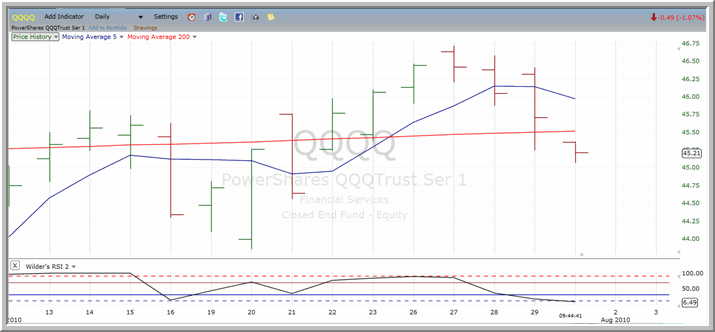High Probability Trading Report: Strategies for the End of the Tech Rally (SPY, SMH, QQQQ)
Technology-related exchange-traded funds (ETFs) have been rallying along with the broader market since early July. While the ^SPY^ (below) is up more than 6% for the month of July, the ^XLK^ is up well over 7%. Leveraged technology funds, predictably, have performed even more impressively over the past 30 days. The ^ROM^ gained 16% over the course of July, while the ^TYH^ advanced by more than 23%.

All that progress means is that profit-taking would be right around the corner and, over the past few days, sellers have stepped into the market to do just that. As a result, a number of these technology-based funds have begun to retreat, with a few slipping back into oversold territory.
^SMH^
One of the more oversold ETFs in our database is SMH.

The SMH has closed in oversold territory above the 200-day moving average for the past two consecutive trading days. The fund rallied back above the 200-day at the beginning of July and is now pulling back toward that level as profit-taking sets in. Additional weakness in the SMH – above the 200-day – will provide opportunities for high probability traders to scale-in at least partially to this increasingly oversold ETF.
^QQQQ^
Many technology-related ETFs are oversold, but have slipped below their 200-day moving averages. This includes XLK, noted above, but also leveraged ETFs like the ^USD^.
Another option for high probability traders looking for pullbacks above the 200-day moving average is the current pullback in the ^QQQQ^.

The QQQQ has closed lower for three days in a row above the 200-day moving average. Having closed below its 5-day moving average for the past two days, the QQQQ is also sliding closer to its 200-day moving average. As with SMH, too aggressive selling may push the fund below its 200-day moving average. But as long as the QQQQ remains oversold above that level, the ETF will remain an attractive potential candidate for high probability traders.
For more high probability trading ideas involving ETFs, click here to learn about our High Probability ETF Trading Software. Based on the 7 quantified, professional trading strategies from the award-winning book by Larry Connors and Cesar Alvarez, High Probability ETF Trading, High Probability ETF Trading Software makes it easier than ever to find the best ETFs to trade every day.
7 Technology Stocks You Need to Know
On the stock side of the high probability trading equation, there are a number of stocks that have become oversold above the 200-day moving average. Traders who are looking for opportunities in stocks may want to consider the pullbacks in some of the following Nasdaq 100 names.
^ALTR^ has closed lower for three days in a row, losing more than 2% on Thursday.
^INTC^ lost more than 1% on Thursday and has also closed lower for three days in a row. The stock is only a few points above its 200-day moving average.
One non-tech Nasdaq 100 name high probability traders may be interested in is ^ROST^, down three days in a row leading into Friday’s trading and off more than 1% on Thursday.
Another non-tech pullback can be found in ^SBUX^. The last time SBUX was this oversold was back in late June, shortly before an oversold bounce took the stock from 23 to 26.
Plunging by more than 2% on Thursday were shares of ^SRCL^. The stock had been trading in a range for most of June and all of July. But strong selling has helped drag the stock into oversold territory above the 200-day moving average ahead of Friday’s trading.
^WYNN^ plunged from neutral territory to oversold territory as it gapped down at the open on Friday. WYNN had been in a strong rally since the beginning of July.
Down three days in a row and off sharply in the first few minutes of trading on Friday were shares of ^XLNX^. XLNX is more oversold than it has been in several months.
Learn how to use short term, high probability trading strategies to trade stocks. Click here to order your copy of Short Term Trading Strategies That Work – 16 quantified strategies tested in bear, bull and sideways markets.
David Penn is Editor in Chief at TradingMarkets.com.
